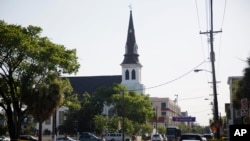The Emanuel African Methodist Episcopal (AME) Church, the site of Wednesday night’s mass shooting, is known as a powerful and symbolic landmark in the struggle for equality among African-Americans.
Again, after nine members perished, it stands as a stark reminder that the struggle continues.
The Charleston, South Carolina, church, also known as “Mother Emanuel,” played a prominent role in the history of African Americans with a congregation that can trace its roots back to the 18th century.
It is the oldest all black congregation south of Baltimore, Maryland.
Charleston native Tessa Spencer Adams, an anchor for ABC News in the city, told VOA the Emanuel AME Church is an integral part of life in Charleston, tightly tied to its history.
“If you didn’t attend, you know someone who did,” she said.
On Thursday, sentiments of mourning were being echoed on Mother Emanuel’s Facebook page where people were posting their condolences over the tragic shooting.
According to the U.S. National Park Service, the congregation formed in 1791 as part of Charleston’s Methodist Episcopal Church. After a dispute over burial grounds, they became part of the African Methodist Episcopal Church.
The 1,400-strong congregation was led by pastor Morris Brown, who was jailed for “violating state and local laws which prohibited religious gatherings of slaves and free blacks independent of white supervision.”
The church has been destroyed and rebuilt twice of the course of its history.
According the U.S. National Park Service, in 1822, the church was believed to be involved in a planned slave revolt organized by one of the church’s founders, Denmark Vesey. Vesey, a former slave, became a successful carpenter, but his involvement in the revolt led to his arrest and execution, along with 35 others.
The church was burned down in the wake of the planned revolt, later rebuilt and subsequently shuttered in 1834 when black churches were outlawed.
The congregation continued to meet in secret up until the end of the Civil War when the church reopened and adopted its current name.
In 1886, the church suffered severe damage in an earthquake and was largely rebuilt again.
In the 1960s, Emanuel African Methodist Episcopal (AME) Church attracted many of the nation’s civil rights leaders, including Dr. Martin Luther King Jr.
Other African-American luminaries such as Booker T. Washington, Roy Wilkins and Coretta Scott King have been welcomed by the congregation.
The Gothic Revival-style church is recognized as a historically significant building in Charleston. It was added to the National Register of historic places in 1985.
Charleston is known as “The Holy City” because of the many steeples that are prominent in the city’s skyline. Some attribute the fact that Charleston is home to so many churches representing a variety of faiths to the fact that Charleston was a bastion of religious tolerance in U.S. colonial times.







